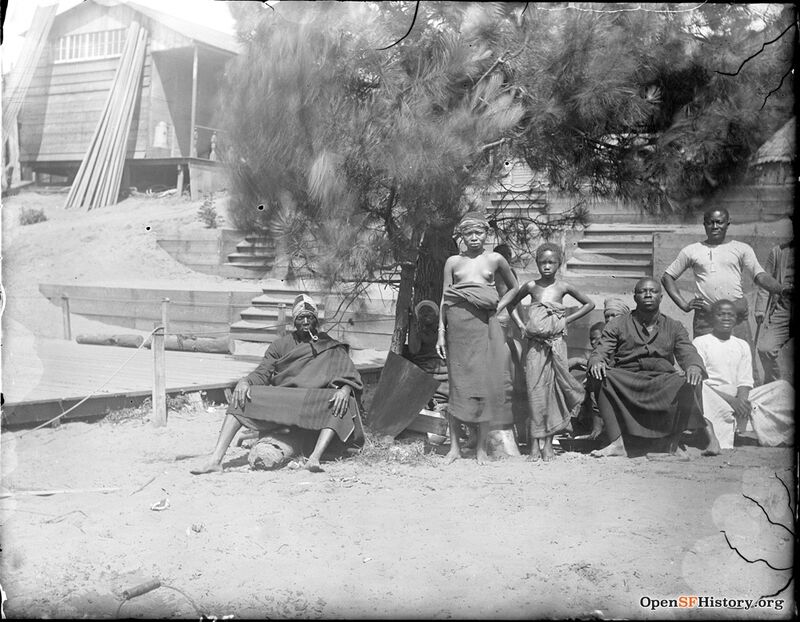Bert Williams - Vaudevillian: Difference between revisions
m (1 revision(s)) |
No edit summary |
||
| (4 intermediate revisions by 2 users not shown) | |||
| Line 1: | Line 1: | ||
'''<font face = arial light> <font color = maroon> <font size = 3>Unfinished History</font></font> </font>''' | |||
[[Image:perfarts$bert-williams-photograph.jpg]] | [[Image:perfarts$bert-williams-photograph.jpg]] | ||
Bert Williams, first black to star in the Ziegfeld Follies. | '''Bert Williams, vaudevillian (1874-1922), first black to star in the Ziegfeld Follies.''' | ||
''Photo: Museum of Performance and Design'' | |||
[[Image:Bert-williams-and-george-walker-2.jpg|right]] | |||
''' | '''Bert Williams and George Walker''' | ||
One of the first [[African-American | One of the first [[Category:African-American |African American]] performers to attain Broadway celebrity and the first to star in the popular Ziegfeld Follies, singer/comedian Bert Williams was much loved by audiences and greatly respected by his colleagues. As a young man, Williams honed his skills in minstrel shows and variety clubs in San Francisco, where he met his partner, George Walker. Together they were hired to be "Dahomey natives" in the 1894 California Midwinter Fair, alongside the actual Dahomeyans that managed to arrive. | ||
[[Image:Dahomey Village group portrait wnp15.130.jpg|800px]] | |||
'' | '''Dahomey Village group portrait, 1894 California Midwinter Fair, Golden Gate Park.''' | ||
''Photo: OpenSFHistory.org wnp15.130'' | |||
<blockquote>[Bert] Williams and [George] Walker were not only tremendously successful, they were racial pioneers. In their subtlety and humanity, the characters Williams and Walker played went beyond the crude racist stereotypes that had hitherto constrained black performers. Walker asserted that their knowledge of Africans was partly responsible: “I have no hesitation in stating the departure from what was popularly known as the American ‘darky’ ragtime limitations to native African characteristics has helped to greatly increase the value of the black performer on the American Stage.” | |||
History, T.S. Eliot said, has many cunning passageways and contrived corridors, but few can be as unlikely, and ironic, as the story of Bert Williams and the Dahomey Village. If a weird African anthropological spectacle at [[California Midwinter Fair of 1894: An Orientalist Exposition|a world’s fair in 1894 San Francisco]] had not needed some American ringers, two young men would never have gained the cultural knowledge that helped them change the history of black performance in the United States. | |||
—from ''Spirits of San Francisco: Voyages Through the Unknown City''<br> | |||
by Gary Kamiya and Paul Madonna, Bloomsbury Publishing: 2020 </blockquote> | |||
[[Image:Dahomey village wnp37.03140.jpg|800px]] | |||
'''Dahomey Villagers posing for camera, 1894.''' | |||
''Photo: OpenSFHistory.org wnp37.03140'' | |||
[[Image:1903-song-hits-of-in-dahomey-williams-walker-1.jpg]] | |||
'''The first all-black musical to be staged on Broadway in the United States.''' | |||
[[Edwin Booth - Actor |Prev. Document]] [[Black Crook |Next Document]] | [[Edwin Booth - Actor |Prev. Document]] [[Black Crook |Next Document]] | ||
[[category:Performing Arts]] [[category:1890s]] [[category:1900s]] [[category:1910s]] [[category:African-American]] | |||
Latest revision as of 23:08, 9 December 2020
Unfinished History
Bert Williams, vaudevillian (1874-1922), first black to star in the Ziegfeld Follies.
Photo: Museum of Performance and Design
Bert Williams and George Walker
One of the first performers to attain Broadway celebrity and the first to star in the popular Ziegfeld Follies, singer/comedian Bert Williams was much loved by audiences and greatly respected by his colleagues. As a young man, Williams honed his skills in minstrel shows and variety clubs in San Francisco, where he met his partner, George Walker. Together they were hired to be "Dahomey natives" in the 1894 California Midwinter Fair, alongside the actual Dahomeyans that managed to arrive.
Dahomey Village group portrait, 1894 California Midwinter Fair, Golden Gate Park.
Photo: OpenSFHistory.org wnp15.130
[Bert] Williams and [George] Walker were not only tremendously successful, they were racial pioneers. In their subtlety and humanity, the characters Williams and Walker played went beyond the crude racist stereotypes that had hitherto constrained black performers. Walker asserted that their knowledge of Africans was partly responsible: “I have no hesitation in stating the departure from what was popularly known as the American ‘darky’ ragtime limitations to native African characteristics has helped to greatly increase the value of the black performer on the American Stage.”
History, T.S. Eliot said, has many cunning passageways and contrived corridors, but few can be as unlikely, and ironic, as the story of Bert Williams and the Dahomey Village. If a weird African anthropological spectacle at a world’s fair in 1894 San Francisco had not needed some American ringers, two young men would never have gained the cultural knowledge that helped them change the history of black performance in the United States.
—from Spirits of San Francisco: Voyages Through the Unknown City
by Gary Kamiya and Paul Madonna, Bloomsbury Publishing: 2020
Dahomey Villagers posing for camera, 1894.
Photo: OpenSFHistory.org wnp37.03140
The first all-black musical to be staged on Broadway in the United States.





